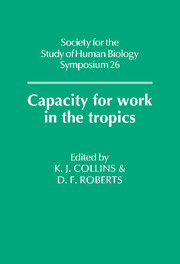Book contents
- Frontmatter
- Contents
- Preface
- Measurement of Working Capacity in Populations
- Functional Consequences of Malnutrition
- Growth, Stature and Muscular Efficiency
- Ethnic and Socio-Cultural Differences in Working Capacity
- Energy Expenditure and Endemic Disease
- Malaria: working capacity in a holo- and mesoendemic region of Liberia
- Schistosomiasis: field studies of energy expenditure in agricultural workers in the Sudan
- Research Models in Tropical Ecosystems
- Index
Malaria: working capacity in a holo- and mesoendemic region of Liberia
Published online by Cambridge University Press: 15 March 2010
- Frontmatter
- Contents
- Preface
- Measurement of Working Capacity in Populations
- Functional Consequences of Malnutrition
- Growth, Stature and Muscular Efficiency
- Ethnic and Socio-Cultural Differences in Working Capacity
- Energy Expenditure and Endemic Disease
- Malaria: working capacity in a holo- and mesoendemic region of Liberia
- Schistosomiasis: field studies of energy expenditure in agricultural workers in the Sudan
- Research Models in Tropical Ecosystems
- Index
Summary
INTRODUCTION
There is a widespread but preconceived opinion held by many laymen, medical personnel, politicians or aid organisations, that working capacity is impaired in chronic parasitic diseases. There are clearcut reasons to suggest this when, for example, Schistosomiasis is followed by liver fibrosis or malignancy of the urogenital tract, or when malaria has been complicated by perimyocarditis. Generally, however, we know little about the consequences of toxins or other antigens spread systemically without giving rise to permanent morphological changes in various organs. One of the examples would be malaria in which, more or less continuously, liberation of antigens foreign to human proteins occurs. Though not demonstrable in histopathology, this may nevertheless impair the function of visceral tissues.
Many years ago, Bentgsson (1956, 1957) reported that physical working capacity was impaired in acute bacterial and viral infections in patients who had demonstrable involvement of the cardiovascular or respiratory systems, as well as in cases of anaemia, according to the aetiology and severity of the disease. There are few investigations of working capacity in chronic infectious and parasitic diseases which do not involve respiratory, cardiac or blood tissues, although there are known to be important practical implications. The reason for the paucity of scientific anlayses may be the difficulty in finding adequate and reliable methods. Of the socioeconomic implications, the level of wages, living standards, absenteeism from work, etc., have been examined. Among the earliest of such analyses, Fenwick and Figenschou (1972) studied the effect of Schistosoma mansoni infection on the productivity of cane-cutters on a sugar estate.
- Type
- Chapter
- Information
- Capacity for Work in the Tropics , pp. 227 - 234Publisher: Cambridge University PressPrint publication year: 1988



